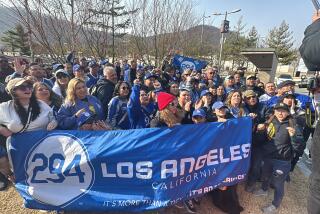Quayle Visits Panmunjom Truce Village
PANMUNJOM, Korea — Casting aside security concerns to take a closer look at one of the world’s tensest borders, Vice President Dan Quayle today became the highest-ranking U.S. official ever to visit this truce village in the Korean demilitarized zone.
While American Presidents and vice presidents have visited South Korea and the DMZ on several occasions, they have avoided trips to Panmunjom because of the proximity of North Korean troops and the difficulty of ensuring security. Secret Service agents had ruled out a visit by Quayle for that reason.
But after visiting several other DMZ outposts, Quayle made a last-minute decision to change the route. Accompanied by his wife, Marilyn, and Donald Gregg, U.S. ambassador to South Korea, Quayle climbed to the top of the pagoda tower overlooking the border and conference building here. As he watched, U.S. troops photographed North Korean troops photographing the official visitors.
Earlier in the morning, Quayle descended 200 feet below the DMZ to inspect a North Korean infiltration tunnel dug a decade ago under the rolling hills of the border region.
“If anybody thinks North Korea is a passive nation, I suggest they go down and visit this tunnel,” Quayle said as he emerged.
The tunnel, wide enough for four soldiers to march abreast, is one of three discovered in the late 1970s. Army officials believe the North Koreans dug the tunnels under the 2 1/2-mile-wide DMZ as a potential invasion route to the south.
“I think it shows the fanaticism of that nation,” Quayle said, “and how far they are willing to go to export destabilization.”
The tunnel inspection and the tour of Panmunjom capped a two-day trip to South Korea. The visit was the first stop on a four-nation Asian tour that will take Quayle to Japan, the Philippines and Malaysia before he returns to Washington on Sept. 29.
DMZ Tour Dramatizes Theme
The DMZ tour was designed to dramatize the central theme of Quayle’s visit here--the continuing military threat posed by North Korea and the resulting need to keep 43,000 U.S. troops stationed in the south.
As he stressed the need for a continued military presence, Quayle soft-pedaled concerns over continued human rights violations in South Korea. He praised the south’s “political transformation and movement toward democracy” and complimented President Roh Tae Woo on “moderation in the face of radical violence that seems designed to provoke overreaction.”
Although U.S. Embassy officials have expressed private concerns over the human rights situation here, the Administration has carefully avoided any public criticism of Roh and his government.
Korean opposition leaders charge that after two years of liberalization, Roh’s government recently has turned toward a more repressive course. They cite figures released Tuesday by a committee of the Korean National Assembly that show a sharp increase in arrests under the country’s strict National Security Act.
In addition, the government last month indicted Kim Dae Jung, the nation’s best-known opposition figure. The indictment, which Kim has denounced, charges that he failed to report an opposition legislator’s trip to North Korea and received money from the legislator that the legislator received from North Korean agents.
But Quayle sidestepped that issue in meetings with Roh, Kim and other Korean leaders. Roh, U.S. officials said, assured Quayle that he “would not turn back” toward repressive policies of past Korean governments. “The vice president was happy about that,” spokesman David Beckwith said.
Although complaints of a government crackdown have been a major part of the opposition’s political program, neither Kim Dae Jung nor Kim Young Sam, the other main opposition leader, raised the issue directly during a meeting with Quayle at the National Assembly on Wednesday afternoon.
More to Read
Get the L.A. Times Politics newsletter
Deeply reported insights into legislation, politics and policy from Sacramento, Washington and beyond. In your inbox three times per week.
You may occasionally receive promotional content from the Los Angeles Times.











